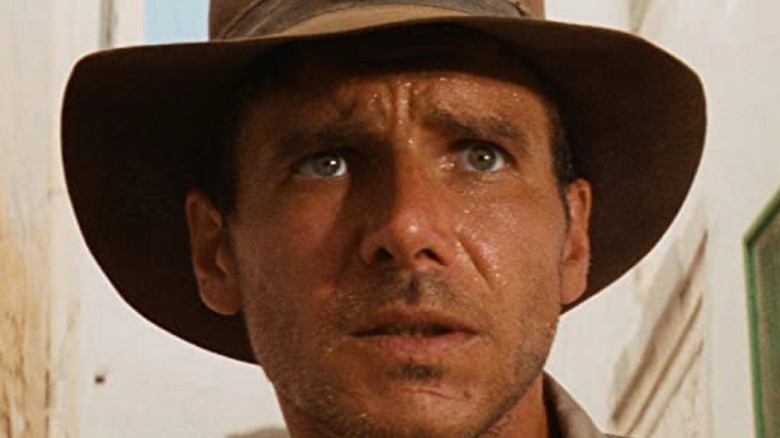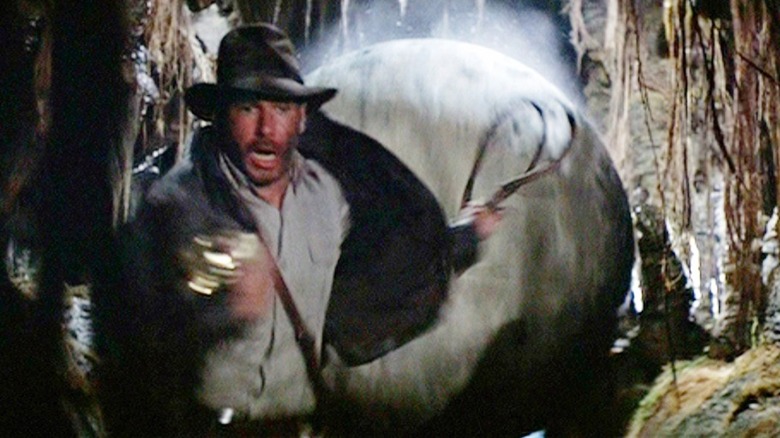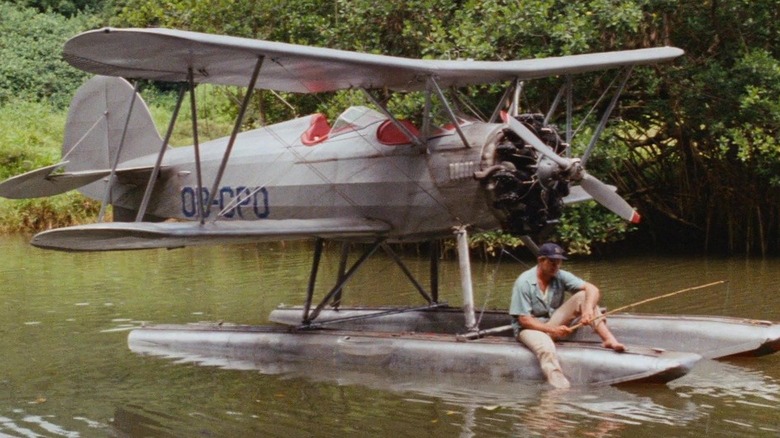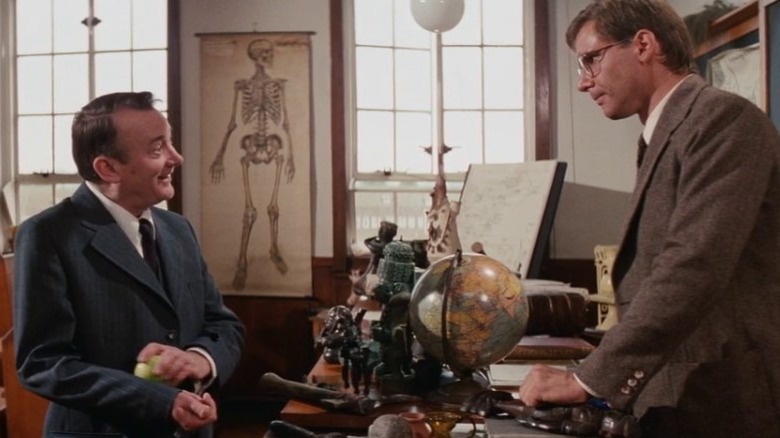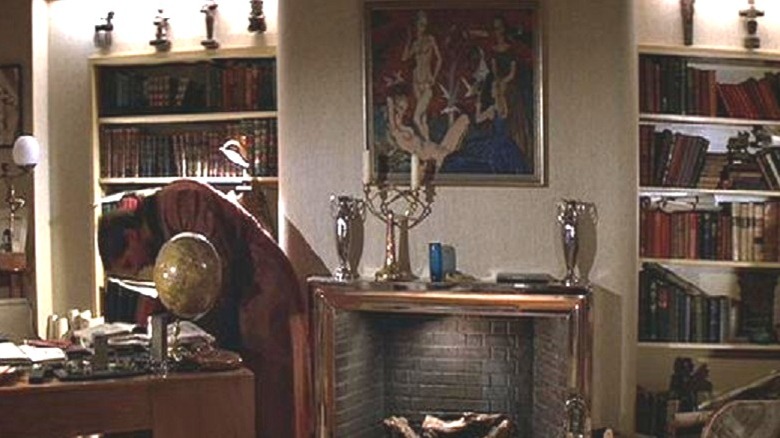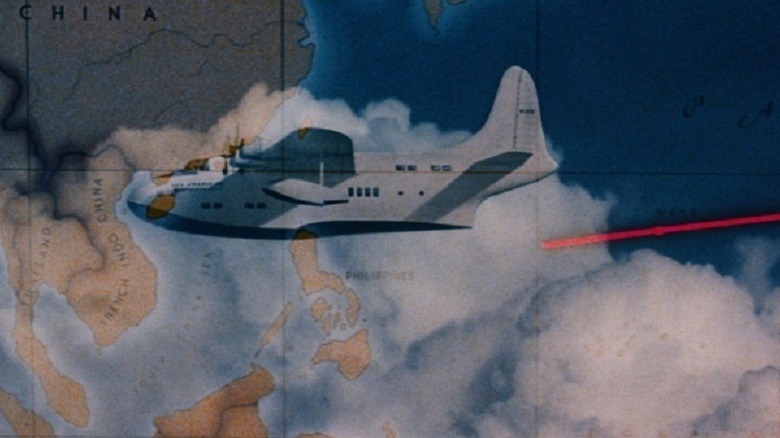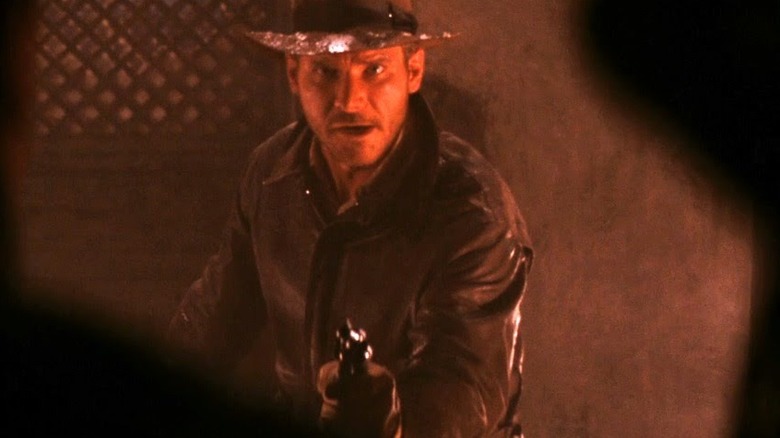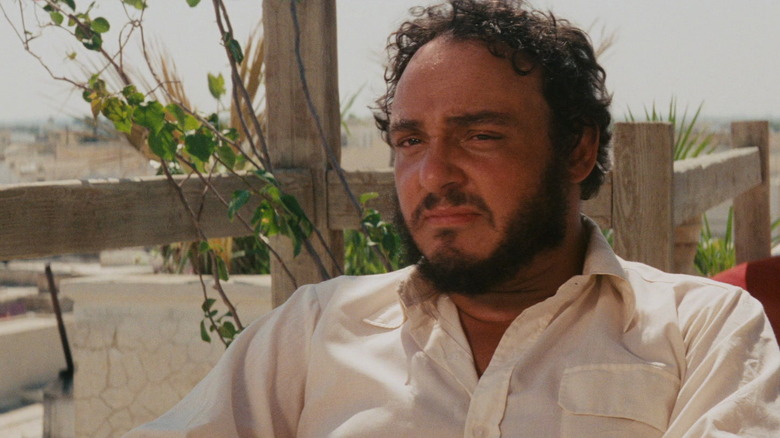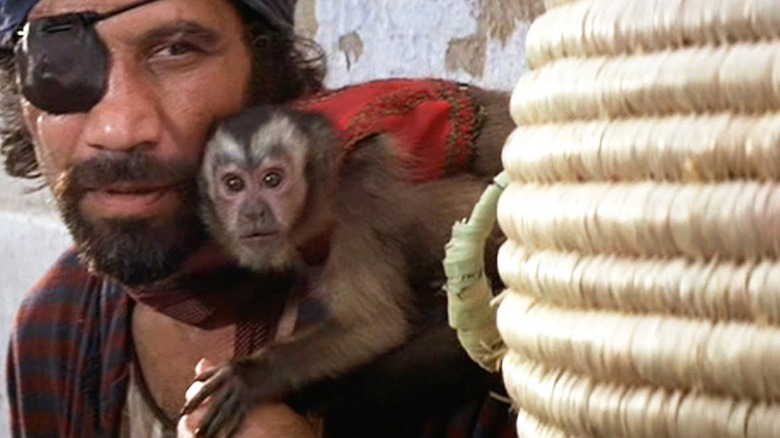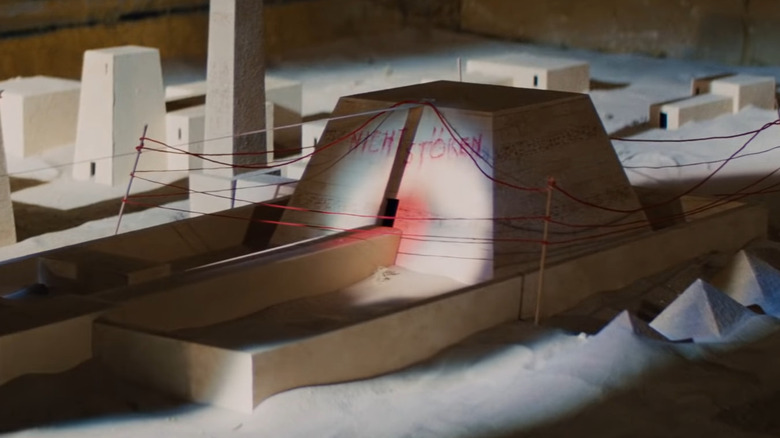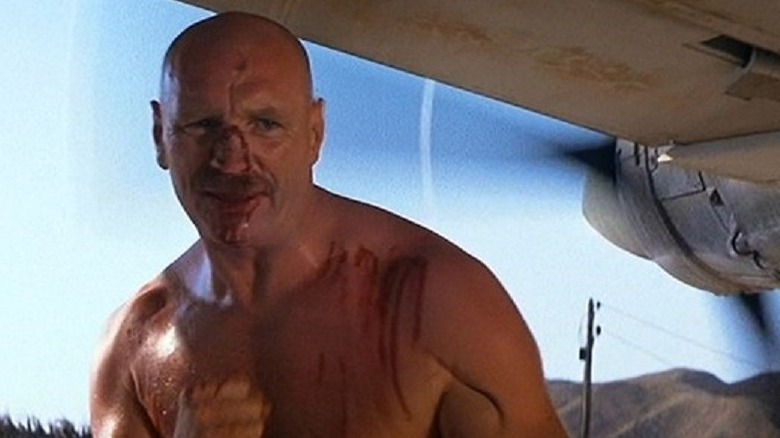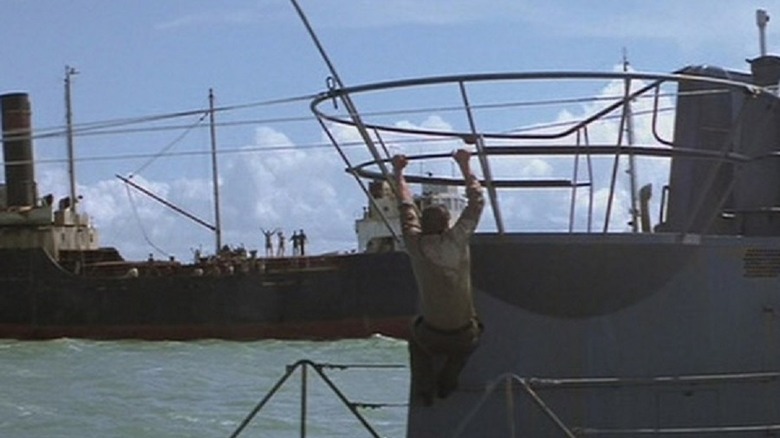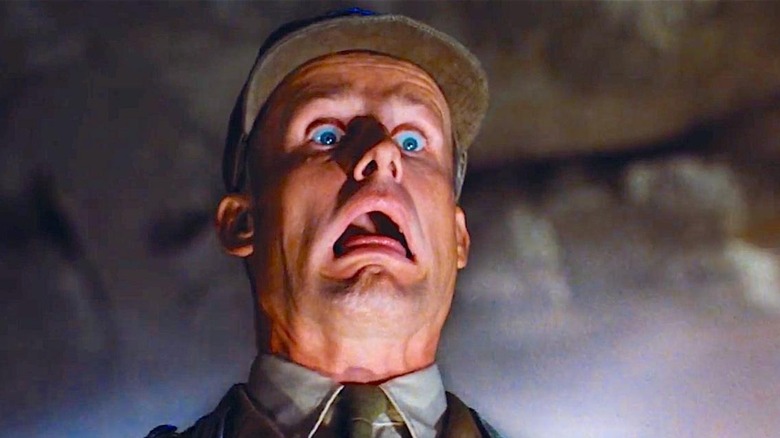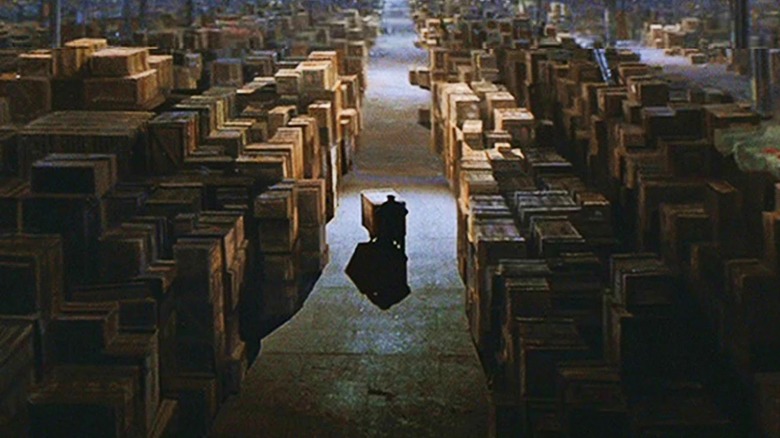Things You Only Notice In Raiders Of The Lost Ark The More You Watch It
"I'm just making this up as I go." That line, delivered by Indiana Jones when asked for his plan, is part of what makes Indy one of the greatest action heroes of all time. Few movies blend so much comedy, intelligence, and adventure; few movies blend such amazing scripted storytelling with brilliant improvisations; arguably none have done it as well as "Raiders of the Lost Ark."
When you talk about legendary creatives collaborating at the top of their games, nothing compares with the film's Steven Spielberg/George Lucas combo (and if you throw in writer Lawrence Kasdan and actor Ford, you've got a talent squad that rivals the 1992 US Olympic Dream Team).
Since re-named "Indiana Jones and the Raiders of the Lost Ark" for home video release, the film currently ranks 66th on the American Film Institute's top 100 list and has spawned three sequels, with a fourth on the way. Undoubtedly, you've seen the film, but there are a lot of details you'll only notice on the second, or third, of 23rd viewing. Plus, the movie pulls you in so much that you may have missed some glaring inconsistencies.
So kick back, watch that Lucasfilm logo splash across the screen, and enjoy the Paramount logo transforming into a real mountain in Indy's South America while we re-watch "Raiders of the Lost Ark."
The boulder wasn't trying to crush Indiana
The opening to "Raiders of the Lost Ark" is considered one of the most famous intro scenes of all time. Everybody knows how it ends: a massive boulder rolling down on Indy while he sprints for his life, stumbling, and just barely jumping out of the way.
It seems at first watch like the boulder's trying to crush him. But after watching it a few times, it's clear that the boulder isn't looking to crush the archaeologist, it's actually a race against time, as the boulder is moving to lodge itself in the entrance and lock him inside the temple. Which is ironic because although it's one of the most unforgettable scenes in cinema — an archaeologist desperately racing a crushing rock — it's also completely pointless, because there's another way out.
Keep your eyes peeled when Indy's trying to jump back across the chasm, after being double-crossed by his guide. Shot from below, the scene clearly reveals open sky above Indy. So, even if the rock had outraced Indy and sealed the temple shut, our hero could have just climbed up and out the roof and walked through the jungle to Jock's pontoon plane. Actually, in doing so, he might have also circumvented the ambush waiting outside the cave entrance.
Lots of "Star Wars" references
Amidst all the action of a man who just survived a series of elaborate booby traps, running from tribesmen shooting poisoned darts, you might miss the identification number on the side of Jock's plane, his getaway vehicle. But there it is, OB-CPO.
The real clue is in co-creator and executive producer George Lucas (the creator of "Star Wars," in case you live under a cinematic rock). OB-CPO is obviously a combination of Obi-Wan and C-3PO. These "Star Wars" references aren't as overt as, say, in "Temple of Doom," where the nightclub the opening scene is called Club Obi Wan. But undoubtedly, George Lucas was very interested in telling you where the money and clout for this Indiana Jones movie came from. There's also another famous, similar Easter egg: Behind Indiana Jones in one scene, on a wall filled with hieroglyphics, sharp-eyed fans can spot the iconic image of Princess Leia loading her message into R2-D2.
The most prominent "Star Wars"-evoking element of "Raiders," however, might be the John Williams score. If you listen to the theme for Marion and the theme for Princess Leia, they sound strangely similar. One video explaining how Williams composes his motifs explains how the last three notes from Leia's theme get retrograded for Marion's theme, and then two notes from Marion's theme get transposed for the "Star Wars" love theme. This may be circumstantial, since Williams does repeat a lot throughout his works. However, a story about how Spielberg had Williams combine both of his ideas for Indiana Jones themes to create the eventual Indy "Raiders of the Lost Ark" theme makes one think Spielberg had a great deal of input on this score.
The high price of a trip to Marrakech
Indy at one point begs Marcus to get him funding for a trip to Marrakech to get a piece back, saying it'll only cost about $2000. That amount of money in 1936 would be about $40,000 today.
Since the university seems to be set in New England, it's worth pricing out what it would currently cost to fly out of the not-too-distant JFK to RAK (Marrakech). As of August 2021, flight estimates range from $700 to $1000 for a plane ticket less than two weeks out, up to around $10000 for first class; add in an average of $400 a night for a stay at a Marrakech hotel like the Four Seasons (per a quick pricing on Expedia), and another two hundred dollars per diem for a 10-day trip. All in, a modern estimate of a first-class-all-the-way still journey to Marrakech lands a little under $20,000.
So, unless Indy needs a lot of extra dough (and one has to wonder what museums have endless endowments that make such expeditions feasible), Dr. Jones certainly travels in style. Or maybe it was just tough to get to Morocco in 1936 — after all, it was the location and year of the beginning of the Spanish Civil War.
Indy's painting is a real masterpiece
The scene of Indy's home has no-doubt inspired intellectuals' busy home décor ever since. There are books and trinkets spread haphazardly throughout the residence, but one very noticeable piece is the painting hanging front and center above his fireplace.
Take a good look, and it looks like a cool modernist or deco painting. From a distance, it has a Picasso "Les Demoiselles d'Avignon" feel to it. But if you were an art major with a focus on deco and modernism, you'd realize is instead another painting, "Les Perruches (The Parrots)" by Jean Dupas.
Since no prop is just haphazardly thrown into a movie, even a painting with two seconds of screentime, this must have been done on purpose. At the least, it was to show the refinement and intellectualism that makes this gun-toting, leather jacket adventurer so indelible. Plus since the painting was done in the 1920s, it's possible that Indy could have bought it new. So, next time the painting comes to auction, fork over a few bucks and you could say you own Indiana Jones' wall art.
Some serious aviation issues
"Raiders of the Lost Ark" has another famous trademark: the flight and travel maps that show the adventurer's globe-trotting. While these transitions manage to make a man sitting on a plane captivating, the more you watch it the more problems you'll find, especially if you have any historical or geographical knowledge.
Let's start with the seaplanes, specifically the fact that there's a lot of them. Not only is there a seaplane in South America but Indy also leaves America in a sea plane. This seaplane is shown in the background of Indy's travelogue to Nepal, implying he's on the plane the whole way. One has to wonder what Nepalese sea it lands in. This, however, is the least of our concerns.
Let's remember the fact that this is 1936. On the map, Indy flies over Thailand; in 1936, however, it would still be called Siam for another three years. Jordan would be called Transjordan for another decade after Indy's flight, yet the map shows it as Jordan.
Then, there's one more issue, and it's a big one. Indy seems to fly to Nepal. But Nepal had no aviation to speak of until 1949. Maybe the plane graphic was just to show him flying out of America and he actually went over land into Nepal? That still wouldn't explain why the graphic flying Nepal to Karachi en route to Cairo shows another plane (though at least this time, it's a DC-3 with landing gear).
Indy has an infinite revolver cylinder
The first great fight in "Raiders of the Lost Ark" occurs in a bar in the wilds of Nepal. During that fight, the unmistakable sound of Indy's heavy revolver echoes through the bar as he and Marion fend off a team of Nazis. As the Nazis and local henchmen shoot pistols and machine guns at our heroes, Indy blasts shot after shot.
Of course, a revolver can hold only six shots in the cylinder, and even with a quick reload there'd be quite a noticeable gap between the sixth and the seventh shot. Yet, during the fight, you hear Indy blast into the double digits with hardly any break at all. When he finally does go to reload, we see how difficult this actually is. Each bullet gets put in individually, no doubt with some serious fumbling requisite in doing so during a mad firefight, so there's no way he could have just launched off two dozen blasts.
Maybe the movie should be "Indiana Jones and the Endless Bullet Cylinder."
Sallah is a professional excavator
When you first meet Sallah in Cairo, he seems like he's just Indy's old local contact, a fixer and hustler with a voice like a Shakespearean actor. You might even miss the fact that he's Indy's perfect colleague because he's first and foremost a digger.
"I knew the Germans would hire you, Sallah. They couldn't have an excavation in the desert without the best digger in Egypt," says Indiana in Sallah's house. Sallah replies, "The hirer shanghaied every digger in Cairo ... They hire only strongbacks and they pay pennies for them. It's as if the pharaohs have returned."
So not only is Sallah actually a digger (also explaining how Indy so quickly and easily had a crack excavation team), but it seems the Nazis strong-armed everybody in the city, including Sallah, into working for him. Making the king of Cairo, city of the living, the perfect double agent for an archaeologist looking to sneak into a Nazi archaeological site.
But obviously, Sallah brings a lot more to the table than simply being a digger.
The Nazi monkey salutes and squawks a "Heil"
The Nazi spy monkey is one of the more memorable bit characters in "Raiders of the Lost Ark." This bawdy capuchin befriends Indy and Marion, and in the process helps his owner the Monkey Man (played by the same guy who plays the double-crosser Barranca at the beginning) to spy on the duo for the Nazis.
Of course, that monkey is responsible for what Spielberg claimed in the extra features on one of the boxed sets is one of his favorite scenes. It's when the monkey shares a Nazi salute, and the scene required a lot of work for a split-second of cinematic gold.
According to producer Frank Marshall in a 2021 Empire article, "That was quite a day when Steven said, 'Get the monkey to salute.' ... So we devised a process: put a grape on a fishing pole, hold the grape just out of his reach and he would reach. After about 50 takes, it finally looked like he was doing his Heil Hitler."
Of course, there's also a little monkey squawk sounding like a "Heil Hitler," but that was easier. Frank Welker voiced the monkey (and would later voice a similar, though animated, monkey, Apu in Disney's "Aladdin"). When the monkey later dies after eating poisoned dates, you don't feel so bad — because, after all, he was a Nazi.
The Nazis defaced the map room with their dig location
It might be tough to understand how Indy knows almost exactly where to dig if you're not paying attention. Yes, he sees a spot in the map room but when you think about it, it's probably difficult to survey a room in a city buried under sand. Luckily for Indy, the Nazis aren't so subtle.
When the sun ray passes over the model map of the city, the beam hits a building with "Nicht Storen" written on it. This means "Do not disturb" in German, and is how they marked where they think the Well of Souls is, and therefore where they've been digging.
Not only does this allow Dr. Jones to figure out where the light points to in relation to the Nazi dig site (especially important, since he can only be there briefly and the process of location-finding is greatly helped by known sites), it also shows how those scummy Nazis don't even care for the niceties of not defacing ancient artifacts.
The Nazi Harrison Ford fights is the big Thuggee in "Temple of Doom"
Indiana Jones has quite a few fights in "Raiders of the Lost Ark." In most of them he's aided by his trusty hand cannon. But there's one scene where he has to fight a massive bruiser with his knuckles (and some sand) and it doesn't go well for Indy.
His best blows hardly phase the giant Nazi. If you've watched "Raiders of the Lost Ark" more than once, chances are you've also watched its 1984 sequel "Indiana Jones and the Temple of Doom" — and if you've watched them both enough times, you might just notice that Indy has a big fistfight in both against a massive man. Perhaps you've also noticed that they're both played by the same actor, Pat Roach.
The fight against the giant Nazi — credited as 1st Mechanic — sees Indy get popped and slammed something fierce. In the fight against the Head Guard in "Temple of Doom," the same thing happens. Fittingly, given how both of these characters are played by the same actor, Indy doesn't really best either of them with his sheer strength. In "Raiders of the Lost Ark," Pat Roach is killed by the propeller of the errant airplane Marion's sitting in. In "Temple of Doom," Pat Roach is killed when a conveyor belt drags him into a rock crusher.
Poor Pat Roach. He would have had Indy, if only it had been a fair fight.
Indy hides in a U-boat for a day and a half
Indy and Marion escape from Cairo on a smuggling ship owned by a friend of Sallah's. Unfortunately, the Nazis find them with a U-Boat, taking both the Ark of the Covenant and Marion. The captain of the smuggling ship then asks his people to find Indy and one points him out, emerging from the drink, climbing up the U-boat and into the conning tower as the sub dives.
The next scene shows a map of the U-boat heading from near the North African coast to an island north of Crete. This would amount to a couple-hundred-mile submerged trip through the Mediterranean. Using the African coastal city Benghazi as a starting point, since it's pretty close to the approximate pickup spot, the distance to Crete is 353 miles.
The distance from the map spot to the island would be about 250 miles; assuming an average speed of eight knots, that means Indiana Jones spent at least a day hidden in the cramped corners of that U-boat, somehow evading detection.
According to one description of U-boats, "the cramped conditions also meant that there were no places of comfort or places to stretch the legs on board." So, either Dr. Jones must have hidden himself in a torpedo tube, or he was the greatest hide-and-seeker the world has ever known.
"I am uncomfortable with the thought of this Jewish ritual."
Once the U-boat docks, Belloq insists they open the Ark (in what he presumably think is an ancient Hebrew ceremony) before taking it to Die Fuhrer. The Ark of the Covenant as described in "Raiders of the Lost Ark" is said by Indy himself to contain the "Ten Commandments. The original stone tablets that Moses brought down out of Mount Horeb and smashed — if you believe in that sort of thing."
While Moses is mentioned in both Christian and Muslim texts, he is most notable for leading the Israelites out of Egypt. This means the Ark could be considered, first and foremost, a Jewish relic.
This is brought up by Dietrich, the big blond square-jawed Nazi number two, when he tells Belloq" "I am uncomfortable with the thought of this Jewish ritual."
Some viewers miss the implications of Dietrich's line. It is someone addressing the irony of a Jewish relic with supposedly-legendary destructive power being sought by the Nazis. In essence, a holy item that once emitted "lightning ... fire... power of God" to help ancient Israelites defeat their enemies is now in the possession of people who are enemies of their descendants.
So, it's worth asking: Did the lightning at the end of the movie that killed everybody, melted the faces of the head Nazis and made that Frenchman's head explode really do so because they didn't close their eyes? Or was it because they were enemies of the Jewish people? In retrospect, perhaps Dietrich was right to feel uncomfortable.
The final warehouse scene was a matte painting
"We have top men working on it right now," says the US bureaucrat. "Who?" asks Indy. "Top. Men." So, what are those top men doing with this relic of immense power? Putting it into an endless warehouse alongside other forgotten, mysterious objects. That warehouse is vast, it's captivating, it closes the movie and ... it's a painting.
Of course, 1980 predated the modern CGI era, when Spielberg and Lucas could probably have their team whip up a photo-realistic, cavernous warehouse on their cellphones at lunch. For scenes needing elaborate backgrounds in those days, productions hired artists to create paintings on glass, complete with a small cutout that would be attached to the camera, allowing for a sliver of space to photograph someone doing something live-action (in this case, a man pushing a dolly with a box on it). This technique was known as matte painting.
Michael Pangrazio took three months to paint the warehouse at the end of "Raiders of the Lost Ark." Spielberg knew it would have to be realistic, since it would have a good amount of screen time (the end credits roll over the shot), and it truly is a wonder. It might take a few watches and some freeze-framing before you realize the edge is a painting, but an actual person painted each and every single one of those boxes in the background.
